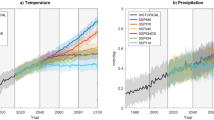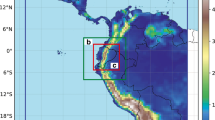Abstract
Surface temperature, precipitation, specific humidity and wind anomalies associated with the warm and cold phases of ENSO simulated by WRF and HadRM are examined for the present and future decades. WRF is driven by ECHAM5 and CCSM3, respectively, and HadRM is driven by HadCM3. For the current decades, all simulations show some capability in resolving the observed warm-dry and cool-wet teleconnection patterns over the PNW and the Southwest U.S. for warm and cold ENSO. Differences in the regional simulations originate primarily from the respective driving fields. For the future decades, the warm-dry and cool-wet teleconnection patterns in association with ENSO are still represented in ECHAM5-WRF and HadRM. However, there are indications of changes in the ENSO teleconnection patterns for CCSM3-WRF in the future, with wet anomalies dominating in the PNW and the Southwest U.S. for both warm and cold ENSO, in contrast to the canonical patterns of precipitation anomalies. Interaction of anomalous wind flow with local terrain plays a critical role in the generation of anomalous precipitation over the western U.S. Anomalous dry conditions are always associated with anomalous airflow that runs parallel to local mountains and wet conditions with airflow that runs perpendicular to local mountains. Future changes in temperature and precipitation associated with the ENSO events in the regional simulations indicate varying responses depending on the variables examined as well as depending on the phase of ENSO.
Similar content being viewed by others
References
Brekke LD, Dettinger MD, Maurer EP, Anderson M (2008) Significance of model credibility in estimating climate project distributions for regional hydroclimatological risk assessments. Clim Change 89:371–394
Cayan DR (1996) Interannual climate variability and snowpack in the western United States. J Clim 9:928–948
Cayan DR, Roads JO (1984) Local relationships between United States West Coast precipitation and monthly mean circulation parameters. Mon Weather Rev 112:1276–1282
Cayan DR, Redmond KT, Riddle LG (1999) ENSO and hydrologic extremes in the western United States. J Clim 12:2881–2893
Chen F, Dudhia J (2001) Coupling an advanced land surface-hydrology model with the Penn State-NCAR MM5 modeling system. Part I: model implementation and sensitivity. Mon Weather Rev 129:569–585
Collins M (2000a) The El Niño-Southern Oscillation in the second Hadley Centre coupled model and its response to greenhouse warming. J Clim 13(7):1299–1312
Collins M (2000b) Understanding uncertainties in the response of ENSO to greenhouse warming. Geophys Res Letts 27(21):3509–3513
Collins WD, Rasch PJ, Boville BA, Hack JJ, McCaa JR, Williamson DL, Kiehl JT, Briegleb B, Bitz C, Lin S-J, Zhang M, Dai Y (2004) Description of the NCAR Community Atmospheric Model (CAM 3.0). NCAR Tech Note, NCAR/TN-464+STR, 226
Collins M, the CMIP modeling group (2005) El Niño or La Niña like climate change? Clim Dyn 24:89–104
Collins W et al (2006) The Community Climate System Model version 3 (CCSM3). J Clim 19:2122–2143
Cubash U et al (2001) Projections of future climate change. Chapter 9. Intergovernmental Panel on Climate Change Third Assessment Report, Cambridge University Press, Cambridge
Deser C, Capotondi A, Saravanan R, Phillips AS (2006) Tropical Pacific and Atlantic climate variability in CCSM3. J Clim 19:2451–2481
Dettinger MD, Cayan DR, Diaz HF, Meko DM (1998) North-south precipitation patterns in western North America on interannual-to-decadel timescales. J Clim 11:3095–3111
Dulière V, Zhang Y, Salathé EP (2011) Extreme precipitations and temperatures over the U.S. Pacific Northwest: a comparison between observations, reanalysis data and regional models. J Clim 24:1950–1964
Gershunov A (1998) ENSO influence on intraseasonal extreme rainfall and temperature frequencies in the contiguous United States: implications for long-range predictability. J Clim 11:3192–3203
Gordon C, Cooper C, Senior CA, Banks HT, Gregory JM, Johns TC, Mitchell JFB, Wood RA (2000) The simulation of SST, sea ice extents and ocean heat transports in a version of the Hadley Centre coupled model without flux adjustments. Clim Dyn 16:147–168.
Hong SY, Pan HL (1996) Nonlocal boundary layer vertical diffusion in a Medium-Range Forecast Model. Mon Weather Rev 124:2322–2339
Hong SY, Dudhia J, Chen SH (2004) A revised approach to ice microphysical processes for the bulk parameterization of clouds and precipitation. Mon Weather Rev 132:103–120
Hong SY, Noh Y, Dudhia J (2006) A new vertical diffusion package with an explicit treatment of entrainment processes. Mon Weather Rev 134:2318–2341
IPCC (2007) Climate change 2007: the physical science basis. Contribution of Working Group I to the Fourth Assessment Report on the Intergovernment Panel on Climate Change, Cambridge University Press, Cambridge, 996 pp
Jones RG, Noguer M, Hassel DC, Hudson D, Wilson SS, Jenkins GJ, Mitchell JFB (2004) Generating high resolution climate change scenarios using PRECIS. Met Office Hadley Centre, Exeter, 40 pp
Kain JS, Fritsch JM (1993) Convective parameterization for mesoscale models: the Kain-Fritsch scheme. In: Emanuel KA, Raymond DJ (eds) The representation of cumulus convection in numerical models. American Meteorological Society, Boston, pp 165–170
Kalnay E et al (1996) The NCEP/NCAR 40-year reanalysis project. Bull Am Meteorol Soc 77:437–471
Knutson TR, Manabe S (1995) Time-mean response over the tropical Pacific to increased CO2 in a coupled ocean–atmosphere model. J Clim 8:2181–2199
Kumar A, Hoerling M (1998) Annual cycle of Pacific-North American seasonal predictability associated with different phases of ENSO. J Clim 11:3295–3308
Leung LR, Qian Y, Bian X, Hunt A (2003a) Hydroclimate of the western United States based on observations and regional climate simulation of 1981–2000. Part II: mesoscale ENSO anomalies. J Clim 16:1912–1928
Leung LR, Qian Y, Han J, Roads JO (2003b) Intercomparison of global reanalyses and regional simulations of cold season water budgets in the western United States. J Hydrometeor 4(6):1067–1087
Leung LR, Qian Y, Bian X, Washington WM, Han J, Roads JO (2004) Mid-century ensemble regional climate change scenarios for the Western United States. Clim Change 62:75–113
Leung LR, Kuo YH, Tribbia J (2006) Research needs and directions of regional climate modeling using WRF and CCSM. B Am Meteorol Soc 87:1747–1751
Liang X, Lettenmaier, DP, Wood E, Burgers, SJ (1994) A simple hydrologically based model of land surface water and energy fluxes for general circulation models. J Geophys Res 99:14415–14428
Marsland SJ, Haak H, Jungclaus JH, Latif M, Roske F (2003) The Max-Planck-Institute global ocean/sea ice model with orthogonal curvilinear coordinates. Ocean Model 5:91–127
Mass, CF (2008) The weather of the Pacific Northwest. University of Washington Press, Seattle
Maurer EP, Wood AW, Adam JC, Lettenmaier DP (2002) A long-term hydrologically based dataset of land surface fluxes and states for the conterminous United States. J Clim 15:3237–3251
Meehl GA, Teng H, Branstator GW (2006) Future changes of El Niño in two global coupled climate models. Clim Dyn 26: 549–566.
Meehl GA et al (2007) Global climate projections. In: Solomon S, Qin D, Manning M, Chen Z, Marquis M, Averyt KB, Tignor M, Miller HL (Eds) Climate change 2007: the physical science basis. Contribution of Working Group I to the Fourth Assessment Report of the Intergovernmental Panel on Climate Change, Cambridge University Press, Cambridge
Merryfield W (2006) Changes to ENSO under CO2 doubling in a multi-model ensemble. J Clim 19:4009–4027
Mitchell TP, Blier W (1997) The variability of wintertime precipitation in the region of California. J Clim 10:2261–2276
Mote PW, Hamlet AF, Clark MP, Lettenmaier DP (2004) Declining mountain snowpack in Western North America. Bull Am Meteorol Soc 48:39–49
Muller WA, Roeckner E (2008) ENSO teleconnections in projections of future climate in ECHAM5/MPI-OM. Clim Dyn 31:533–549
Nakicenovic N et al (2000) IPCC special report on emissions scenarios. Cambridge University Press
Pandey GR, Cayan DR, Georgakakos KP (1999) Precipitation structure in the Sierra Nevada of California during Winter. J Geophys Res 104:12019–12030
Pope VD, Gallani ML, Rowntree PR, Stratton RA (2000) The impact of new physical parameterizations in the Hadley Centre climate model: HadAM3. Clim Dyn 16:123–146
Qian Y, Ghan SJ, Leung LR (2010) Downscaling hydroclimate change over Western U.S. based on CAM subgrid scheme and WRF regional climate simulations. Int J Climatol 30:675–693
Redmond KT, Koch RW (1991) Surface climate and streamflow variability in the western United States and their relationship to large scale circulation indices. Water Resour Res 27:2381–2399
Roeckner E, Bengtsson L, Feichter J, Lelieveld J, Rodhe H (1999) Transient climate change simulations with a coupled atmosphere–ocean GCM including the tropospheric sulfur cycle. J Clim 12:3004–3032
Roeckner E, Bäuml G, Bonaventura L, Brokopf R, Esch M, Giorgetta M, Hagemann S, Kirchner I, Kornbleuh L, Manzini E, Rhodin A, Schlese U, Schulzweida U, Tomkins A (2003) The atmospheric general circulation model ECHAM5, part I: model description. Max-Planck-Institute for Meteorology Report No 349
Ropelewski CF, Halpert MS (1986) North American precipitation and temperature patterns associated with the ENSO. Mon Weather Rev 114:2352–2362
Salathé EP, Steed R, Mass CF, Zahn P (2008) A high-resolution climate model for the US Pacific Northwest: mesoscale feedbacks and local responses to climate change. J Clim 21:5708–5726
Salathé EP, Leung RL, Qian Y, Zhang Y (2010) Regional climate model projections for the State of Washington. Clim Change 102:51–75
Skamarock WC, Klemp JB, Dudhia J, Gill DO, Barker DM, Wang W, Powers JG (2006) A description of the advanced research WRF version 2. NCAR Tech. Note NCAR/TN-468+STR, 88 pp
Sugi M, Noda A, Sato N (2002) Influence of the global warming on tropical cyclone climatology: an experiment with the JMA global model. J Meteorol Soc Jpn 80:249–272
Van Oldenborgh GJ, Philip SY, Collins M (2005) El Niño in a changing climate: a multi-model study. Ocean Sci 1:81–95
Wallace JM, Smith C, Bretherton CS (1992) Singular value decompositions of wintertime sea surface temperature and 500-mb height anomalies. J Clim 5:561–576
Williams KD, Senior CA, Mitchell JFB (2001) Transient climate change in the Hadley Centre models: the role of physical processes. J Clim 14:2659–2674
Zhang Y, Dulière V, Mote P, Salathé EP (2009) Evaluation of WRF and HadRM mesoscale climate simulations over the United States Pacific Northwest. J Clim 22:5511–5526
Author information
Authors and Affiliations
Corresponding author
Additional information
Joint Institute for the Atmosphere and Ocean (JISAO) Contribution No.: 1755.
Rights and permissions
About this article
Cite this article
Zhang, Y., Qian, Y., Dulière, V. et al. ENSO anomalies over the Western United States: present and future patterns in regional climate simulations. Climatic Change 110, 315–346 (2012). https://doi.org/10.1007/s10584-011-0088-7
Received:
Accepted:
Published:
Issue Date:
DOI: https://doi.org/10.1007/s10584-011-0088-7




